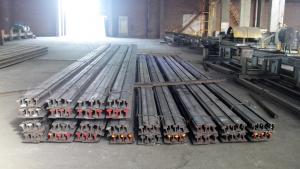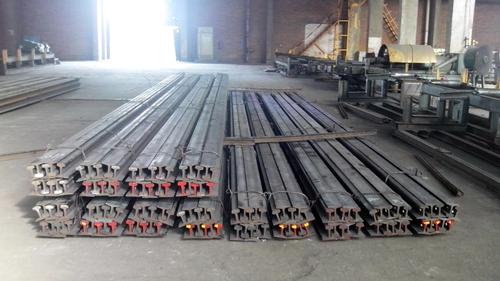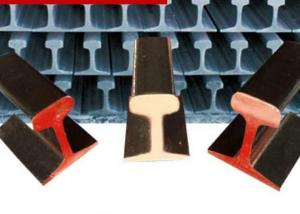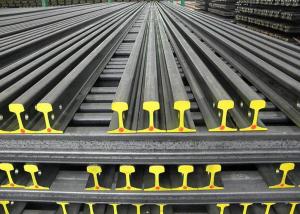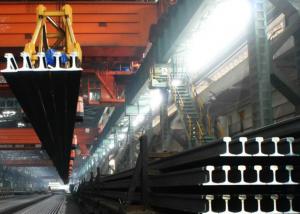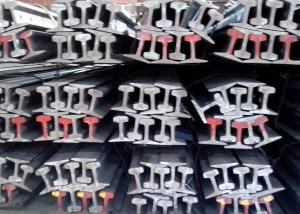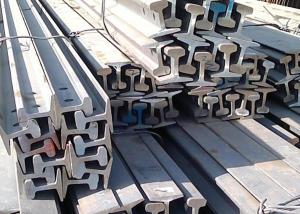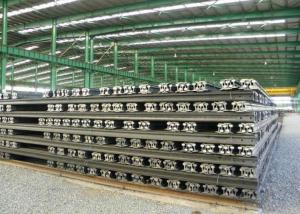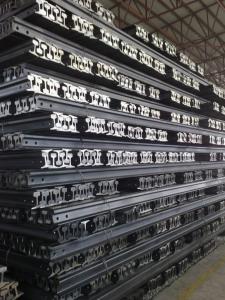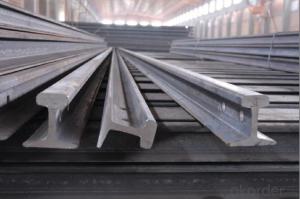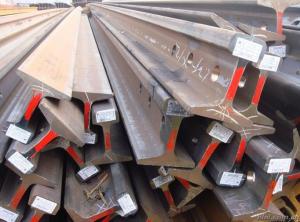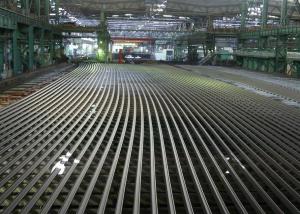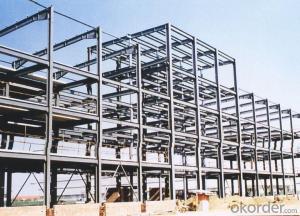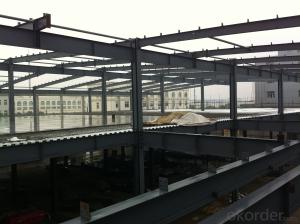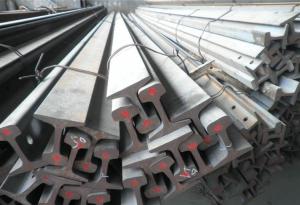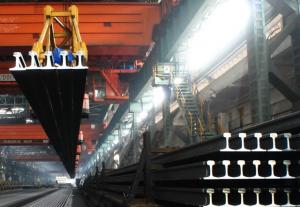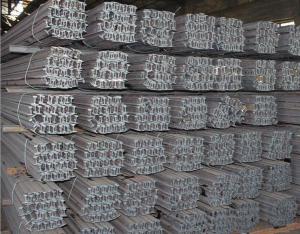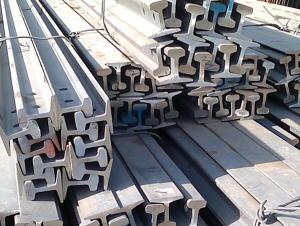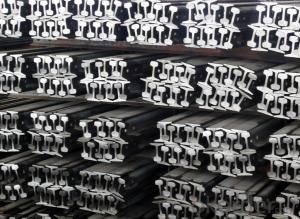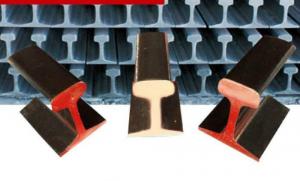Steel Heavy Rail with High Quality for Construction
- Loading Port:
- China main port
- Payment Terms:
- TT or LC
- Min Order Qty:
- 25 m.t.
- Supply Capability:
- 100000 m.t./month
OKorder Service Pledge
OKorder Financial Service
You Might Also Like
Product Description of Steel Heavy Rail with High Quality for Construction:
Sizes: 38kg, 43kg, 45kg, 50kg, 60kg.
Production Standard: GB2585-81, DIN, AREMA, JIS, BS, UIC, etc.
Material: 50MN, U71MN, 900A, 110A, etc.
Length: 6m-25m according to the requriements of the clients
Usages of Steel Heavy Rail with High Quality for Construction:
Light rail is mainly used in forest region, mines, factories and construction sites laid of the place such as temporary transport line and light motorcycles with line. Be widely used for railway, subway, transportation track, express, curve way, tunnel way and so on.
Packaging & Delivery of Steel Heavy Rail with High Quality for Construction:
1. Packing: it is nude packed in bundles by steel wire rod
2. Bundle weight: not more than 3.5MT for bulk vessel; less than 3 MT for container load
3. Marks:
Color marking: There will be color marking on both end of the bundle for the cargo delivered by bulk vessel. That makes it easily to distinguish at the destination port.
Tag mark: there will be tag mark tied up on the bundles. The information usually including supplier logo and name, product name, made in China, shipping marks and other information request by the customer.
If loading by container the marking is not needed, but we will prepare it as customer request.
4. Transportation: the goods are delivered by truck from mill to loading port, the maximum quantity can be loaded is around 40MTs by each truck. If the order quantity cannot reach the full truck loaded, the transportation cost per ton will be little higher than full load.
5. Delivered by container or bulk vessel
6. Delivery Time: All the Hot Rolled Steel Rail will be transpoted at the port of Tianjin, China within 30 days after receiving the advance payment by T/T or the orginal L/C at sight.
Inspection of Steel Heavy Rail with High Quality for Construction:
We will send the MTC of the factory to the clients dirrectly which contain the anlisis of the heat, chemiqul composition, phisical characteristicas, etc.
And our inspectors will arrive at the factory to meke the inspection of the size, length, weight and quantity before the transportation from the factory.
FAQ:
Q1: Why buy Materials & Equipment from OKorder.com?
A1: All products offered byOKorder.com are carefully selected from China's most reliable manufacturing enterprises. Through its ISO certifications, OKorder.com adheres to the highest standards and a commitment to supply chain safety and customer satisfaction.
Q2: How do we guarantee the quality of our products?
A2: We have established an advanced quality management system which conducts strict quality tests at every step, from raw materials to the final product. At the same time, we provide extensive follow-up service assurances as required.
Q3: How soon can we receive the product after purchase?
A3: Within three days of placing an order, we will begin production. The specific shipping date is dependent upon international and government factors, but is typically 7 to 10 workdays
Images:
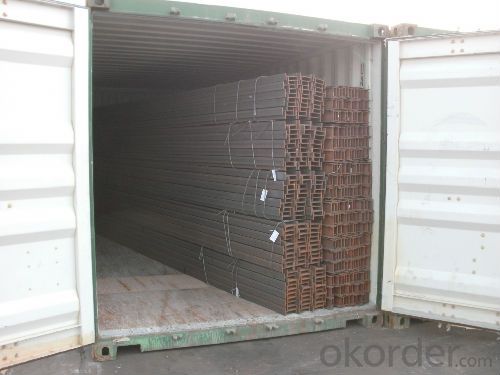
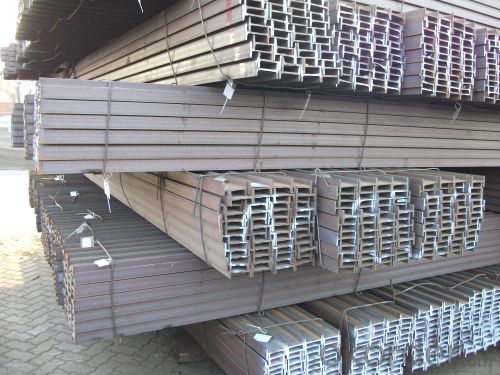
- Q: How much weight can steel rails support?
- The weight that steel rails can support depends on various factors such as the specific type and grade of steel, the dimensions and design of the rail, the support structure, and the conditions of the environment. Generally, steel rails can support significant loads ranging from several tons to even hundreds of tons, enabling the smooth operation of heavy locomotives and trains.
- Q: How do steel rails contribute to energy efficiency?
- Steel rails contribute to energy efficiency in several ways. Firstly, steel is a highly durable material that can withstand heavy loads and extreme weather conditions, reducing the need for frequent repairs and replacements. This durability means less energy is required for maintenance and upkeep of the rail infrastructure. Secondly, steel rails provide a smooth and stable surface for trains to run on, minimizing friction and resistance. This reduced friction translates into lower energy consumption and improved fuel efficiency for trains, as they require less power to travel along the tracks. Additionally, steel rails are designed to be lightweight yet strong, allowing for faster acceleration and deceleration of trains. This enables them to operate more efficiently, as less energy is wasted during start-up and braking. Overall, the use of steel rails in railway systems enhances energy efficiency by reducing maintenance needs, minimizing friction and resistance, and optimizing the performance of trains.
- Q: How are steel rails joined together?
- Steel rails are typically joined together using a process called rail welding, where the ends of two adjacent rails are heated and fused together to form a continuous track.
- Q: How do steel rails contribute to train stability during acceleration and deceleration?
- Steel rails contribute to train stability during acceleration and deceleration by providing a smooth and stable surface for the train wheels to roll on. The steel rails are securely fastened to the ground, making it easier for the train to maintain its course and prevent lateral movement. The high friction between the steel rails and train wheels also ensures that the train stays on track, even during sudden changes in speed. Overall, steel rails play a crucial role in maintaining the stability and safety of the train during acceleration and deceleration.
- Q: Can steel rails be used in low-traffic rural areas?
- Yes, steel rails can be used in low-traffic rural areas. Steel rails are commonly used in railway systems due to their strength, durability, and ability to withstand heavy loads. While low-traffic rural areas may not experience as much train activity as urban areas, using steel rails in these regions can still offer several advantages. Firstly, steel rails are highly resistant to wear and tear, making them suitable for long-term use in any environment. They can withstand the weight and impact of trains passing over them without significant damage, ensuring a safe and reliable transportation system. This durability is especially beneficial in low-traffic areas where maintenance and repairs may be less frequent. Secondly, steel rails provide a smooth and stable surface for trains to travel on, ensuring a comfortable ride for passengers and reducing the risk of derailment. This is essential in rural areas where trains might traverse uneven terrain or encounter challenging weather conditions. Steel rails offer better stability and control, even in remote or less developed regions. Furthermore, steel rails are cost-effective in the long run. While the initial installation cost may be higher compared to other materials, the extended lifespan and low maintenance requirements of steel rails make them a more economical choice. In low-traffic rural areas where budget constraints may be a concern, the longevity and reliability of steel rails can help minimize operational costs. In conclusion, steel rails can indeed be used in low-traffic rural areas. Their strength, durability, and cost-effectiveness make them a suitable choice for ensuring safe and reliable transportation systems in such regions. Whether it is for freight transportation or passenger services, steel rails provide the necessary infrastructure for efficient and secure rail operations in rural areas.
- Q: What is the impact of high-speed trains on steel rails?
- Steel rails are greatly affected by high-speed trains because of the immense forces and stresses they generate. The high speeds at which these trains operate result in increased wear and tear on the steel rails, requiring regular maintenance and replacement. The main impact of high-speed trains on steel rails is the occurrence of wear and fatigue. The weight and speed of these trains exert tremendous pressure on the rails, causing them to gradually wear down over time. This wear is typically seen in metal loss, surface deformation, and rail head damage. The constant friction between the train's wheels and the rails generates heat, further contributing to the degradation of the steel rails. To reduce the impact of high-speed trains, steel rails are made from materials that are strong and resistant to wear. These materials are specifically designed to withstand the immense forces exerted by the trains and have a longer service life. Additionally, the rails are regularly inspected and maintained to identify any signs of wear or damage and prevent potential accidents. The impact of high-speed trains on steel rails also affects the design and construction of the railway infrastructure. The tracks need to be built in a way that can accommodate higher speeds, with reinforced foundations and specialized rail fastening systems. This additional investment in infrastructure is necessary to ensure the safety and reliability of the railway system. Despite the challenges posed by high-speed trains, they also bring certain advantages to steel rails. The increased use of railways for high-speed transportation leads to a higher demand for steel rails, which stimulates the steel industry and supports economic growth. Furthermore, the technological advancements in rail engineering driven by high-speed trains can result in improvements in rail materials and designs, benefiting not only high-speed rail systems but also conventional rail networks. In conclusion, the impact of high-speed trains on steel rails is significant. The wear and fatigue caused by the immense forces and speeds of these trains require regular maintenance and replacement of the rails. However, this impact also drives advancements in rail engineering and stimulates the steel industry, contributing to economic growth and improved rail infrastructure.
- Q: Can steel rails be used in railway sidings or spurs?
- Yes, steel rails can be used in railway sidings or spurs. Steel rails are commonly used in railway tracks due to their durability, strength, and ability to withstand heavy loads. Railway sidings or spurs are essentially additional tracks branching off the main railway line, and steel rails are suitable for these applications as well.
- Q: How do steel rails contribute to reducing fuel consumption in railways?
- Steel rails contribute to reducing fuel consumption in railways through several ways. Firstly, steel rails provide a smooth and stable surface for train wheels, minimizing friction and allowing trains to travel more efficiently. This reduced friction leads to less energy being wasted and ultimately lower fuel consumption. Additionally, steel rails have a longer lifespan compared to other materials, reducing the need for frequent maintenance and replacement. This not only saves on fuel used for maintenance activities but also ensures that trains can operate at optimal efficiency for longer periods. Overall, the use of steel rails in railways plays a crucial role in enhancing fuel efficiency and reducing energy consumption in the transportation sector.
- Q: What are the specifications for steel rail expansion joints?
- The specifications for steel rail expansion joints typically include details such as the material composition, dimensions, load-bearing capacity, and design features. These joints are designed to accommodate the expansion and contraction of steel rails due to temperature variations, ensuring the smooth and safe operation of railway tracks.
- Q: How do steel rails contribute to reducing derailments?
- Steel rails contribute to reducing derailments in several ways. Firstly, steel rails provide a strong and durable track structure, ensuring stability and preventing excessive movement of the train. This reduces the chances of derailments caused by track irregularities or instability. Secondly, steel rails have high resistance to wear and tear, minimizing the risk of rail failure due to fatigue or breakage. This enhances the overall safety of the railway system and reduces the likelihood of derailments. Additionally, the smooth surface of steel rails allows for efficient contact between the train's wheels and the track, reducing friction and enhancing the train's stability during operations. Overall, the use of steel rails helps maintain a reliable and secure track infrastructure, thereby contributing significantly to the reduction of derailments.
Send your message to us
Steel Heavy Rail with High Quality for Construction
- Loading Port:
- China main port
- Payment Terms:
- TT or LC
- Min Order Qty:
- 25 m.t.
- Supply Capability:
- 100000 m.t./month
OKorder Service Pledge
OKorder Financial Service
Similar products
Hot products
Hot Searches
Related keywords
